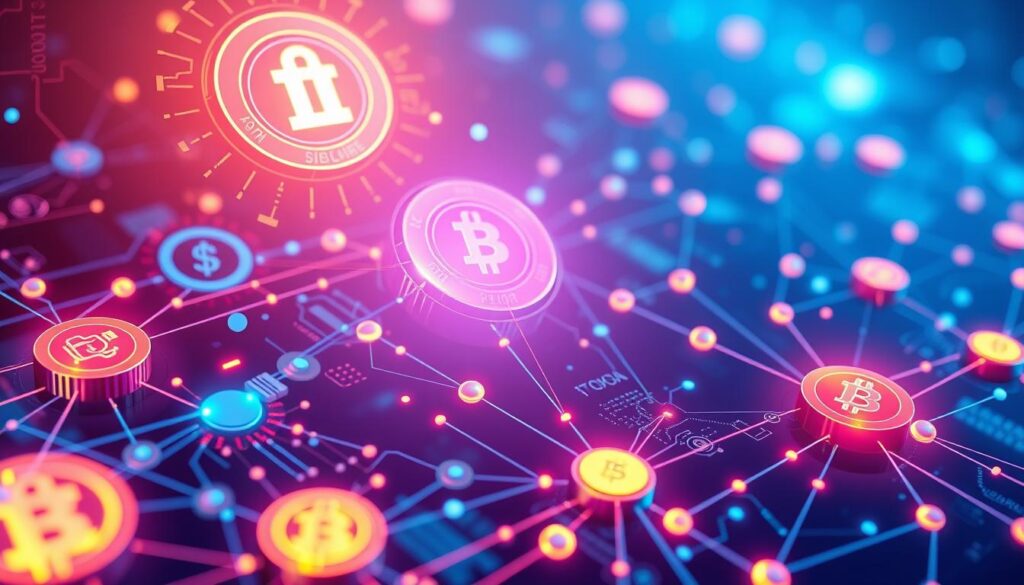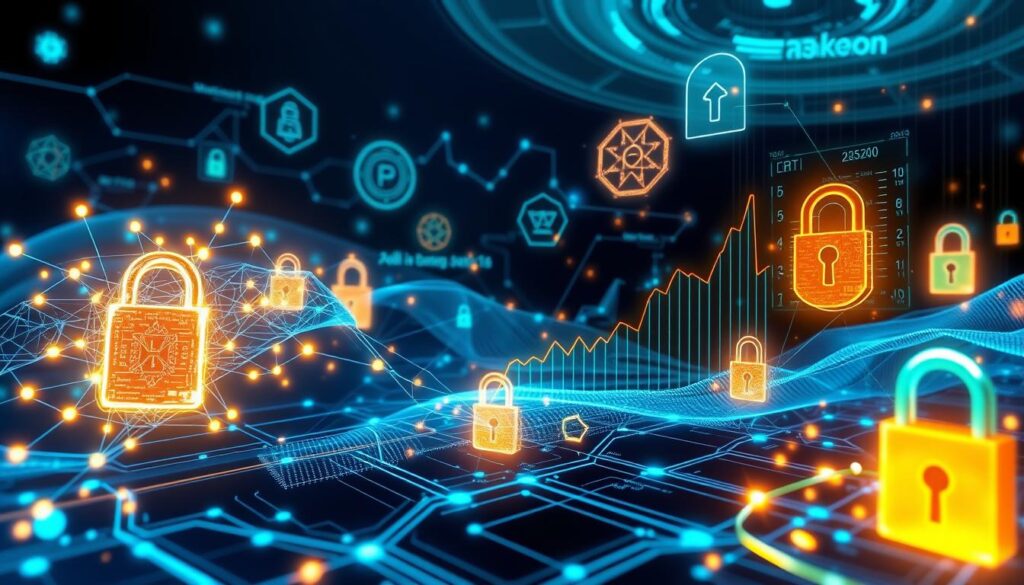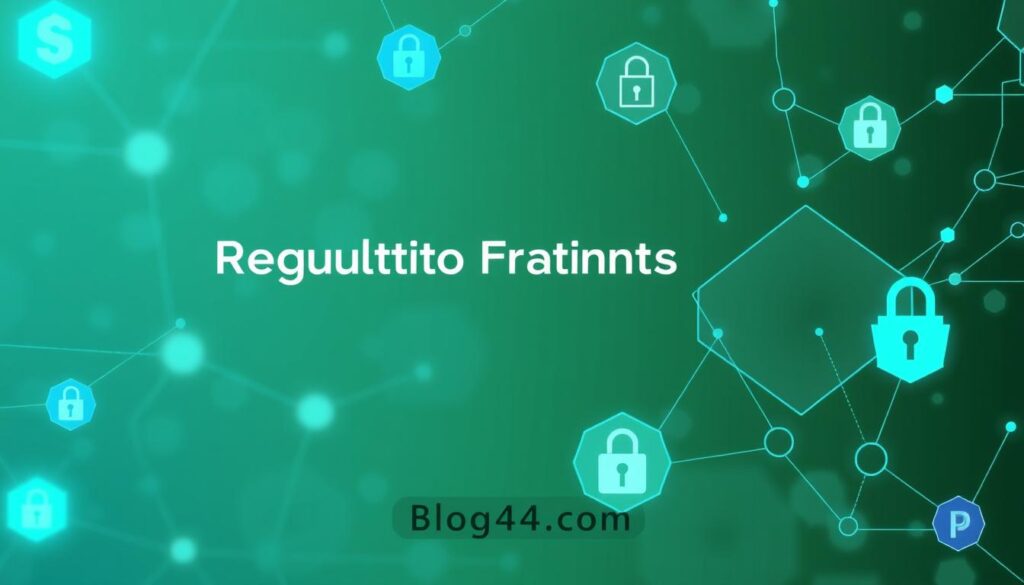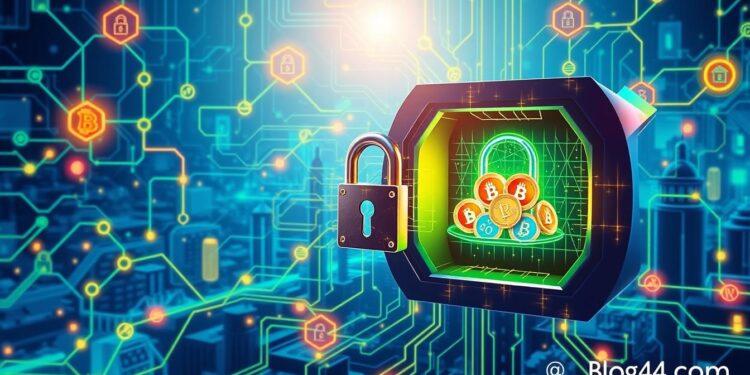Did you know tokenization can turn many assets, like real estate and digital patents, into secure digital tokens1? This new method is changing how we manage digital assets. It brings more liquidity, allows for fractional ownership, and makes transactions faster in many fields. Welcome to tokenization, where the physical and digital worlds are merging, shaping the future of asset security.
In this guide, we’ll explore tokenization’s big impact on digital asset security. You’ll learn how Ethereum, Binance Smart Chain, and Polkadot are making many tokenized assets possible1. We’ll also cover how to follow rules, manage smart contracts, and keep your assets safe1.
If you’re a business looking for new chances or an investor wanting to own digital assets, this guide is for you. It will give you the knowledge to understand tokenization’s fast-changing world. Get ready for a journey that will change how you see digital asset security and access.
Key Takeaways
- Tokenization revolutionizes digital asset security by converting real-world assets into secure digital tokens.
- Leading blockchain platforms like Ethereum, Binance Smart Chain, and Polkadot offer unique features for tokenization.
- Tokenization enables the creation of various token types, including security tokens, utility tokens, and non-fungible tokens (NFTs).
- Regulatory compliance and smart contract management are critical for successful tokenization implementation.
- Robust custody solutions ensure the secure storage and ownership of tokenized assets.
What is Tokenization?
Tokenization turns physical or digital assets into unique digital tokens on a blockchain. It breaks down assets into smaller, tradable units. This makes owning and transferring assets easy and safe2. It’s changing how we deal with and trade assets in finance, real estate, art, and collectibles.
Definition of Tokenization
Tokenization means turning asset ownership into digital tokens on a blockchain. These tokens show the asset’s value and authenticity2. It lets people invest in markets that were once hard to get into.
How Tokenization Works
The tokenization process starts with analyzing an asset’s unique features. Then, these are turned into a digital token on a blockchain3. This token is secure and lets you easily transfer ownership and track the asset.
Tokenization makes assets more accessible, opening up new investment chances2. It’s changing how we manage assets, making markets more liquid and inclusive.
“Tokenization is a game-changer, unlocking new opportunities and empowering individuals to participate in previously inaccessible markets.”
The Importance of Tokenization in Digital Security
Tokenization is key in keeping digital assets safe and fighting fraud. It swaps out sensitive data for safe tokens, keeping info useful but much safer4. This method has shown great results, like Mastercard’s tech boosting approval rates and cutting cart drops4.
It’s also very popular, with Visa and Mastercard tokenizing over 30% of their transactions. This big step cuts fraud risks4.
Protecting Sensitive Data
In today’s world, tokenization is a big help in keeping data safe. It uses unique tokens for things like credit card numbers and bank info5. This way, even if hackers get the tokens, they can’t do anything without the real data5.
It also makes following rules like PCI DSS easier. These rules are strict to keep payment card data safe5.
Mitigating Fraud Risks
Tokenization is a strong ally against fraud5. Each transaction or merchant gets its own token, making fraud much harder5. It also makes customers trust digital payments more, helping businesses grow5.
So, it’s used a lot in places like mobile wallets, online shops, and contactless payments5.
The future of tokenization looks bright, with big hopes for cost cuts and more money from using tokenized assets6. As it gets better, it will keep our digital world safer and smoother, just what today’s shoppers want465.

Types of Tokenization
Tokenization is a flexible method used in many areas to boost digital security. It helps protect financial transactions and sensitive data. Let’s look at the main types of tokenization and what makes them special.
Payment Tokenization
Payment tokenization is key for safe online payments. It swaps out sensitive payment info, like credit card numbers, for unique tokens. These tokens are safer, cutting down fraud and data theft risks.
By hiding payment data, it also helps meet rules like PCI DSS. This leads to lower costs and less risk for businesses7.
Data Tokenization
Data tokenization is great for keeping sensitive info safe in many fields. It changes personal, financial, or medical data into safe tokens. These tokens are not useful without the right access, making them secure7.
This method makes following rules easier and improves data security and use. It’s flexible and works well with different systems8.
Cryptographic Tokenization
Cryptographic tokenization uses advanced methods to make data safe. It uses top encryption, like NIST and FIPS, to protect data well8. This method can handle all kinds of data safely, from simple to complex8.
Each tokenization type has its own role, meeting different security and rule needs. Knowing about these strategies helps businesses pick the best way to protect their digital stuff and follow the rules78.
Key Benefits of Tokenization
Tokenization is a game-changer in digital security and compliance. It turns sensitive data into safe tokens. This makes data breaches less likely and helps companies follow rules better9.
Enhanced Security
Tokenization boosts security big time. It swaps out real data for random tokens, making it less tempting for hackers9. Plus, it makes transactions faster and safer, cutting down on risks9.
Compliance with Regulations
Tokenization is key for sticking to data protection laws like GDPR and PCI DSS9. It keeps sensitive info safe, helping companies meet their legal duties9. But, it also brings its own set of rules to follow, across different places10.
In short, tokenization is a big win for security and following the law. It’s a must-have for keeping your data safe and dealing with legal hurdles confidently.

Tokenization vs. Encryption: What’s the Difference?
Data security is key, and both tokenization and encryption are important. They both aim to protect sensitive info but in different ways. Knowing the difference helps choose the best for your business.
Overview of Encryption
Encryption uses algorithms to make data unreadable. This keeps data safe even if it’s caught by the wrong people. It’s used everywhere to protect things like money and personal info.
When to Use Each Method
Tokenization and encryption work well together. Tokenization is great for keeping customer data safe1112. It’s used a lot in finance, healthcare, and online shopping12. Encryption, on the other hand, is more flexible and can protect many types of data.
Choosing between tokenization and encryption depends on your needs and data type11. Tokenization is good for reducing breach risks and meeting rules like PCI-DSS and GDPR11. Encryption is better for protecting a wide range of data or keeping data in its original form.
| Tokenization | Encryption |
|---|---|
| Replaces sensitive data with non-sensitive tokens | Transforms data into an unreadable format using algorithms |
| Effective in reducing the risk of data breaches and fraud1112 | Versatile technique applicable to a broader range of data types |
| Commonly used in industries handling sensitive customer information12 | Can be used to protect a wide variety of sensitive data |
| Enables secure data sharing without compromising security11 | Ensures data remains unintelligible to unauthorized parties |
| Helps meet compliance standards like PCI-DSS, GDPR, and CCPA11 | Widely used across industries to safeguard sensitive information |
In summary, tokenization and encryption are both strong security tools. They work differently and serve various purposes. Knowing their strengths and weaknesses helps you pick the right data protection for your business.
How Tokenization Works in Payment Systems
Tokenization is a key player in digital payments, making them safer and protecting financial data. It replaces sensitive payment info with unique digital tokens. This helps keep transactions safe and reduces fraud risk13.
Tokenization Process in Transactions
The tokenization process swaps out real payment card details for a unique token. This token stands in for the original data, keeping it safe during transactions1314. It makes payments secure and smooth, without affecting the user’s experience.
Role of Payment Gateways
Payment gateways are key in making tokenized transactions happen. They work with companies like Braintree, Stripe, and Square. These gateways help ensure payments are secure and follow important standards like PCI DSS1315.
By using tokenization, these gateways help businesses avoid data breaches. They also make it easier to follow rules and improve the payment experience for customers.

Tokenization is a strong tool for payment security. It helps businesses fight fraud, build customer trust, and meet industry rules131415. As digital payments grow, tokenization will keep playing a big role in keeping transactions safe and sound.
Implementing Tokenization in Your Business
Tokenization can change how businesses work, but it needs careful planning. First, figure out what your business needs. Then, pick a tokenization provider that fits your needs16.
Assessing Your Needs
Start by looking at how much and what kind of data you need to protect. Tokenization uses blockchain to turn real assets and data into tokens16. Figure out what data you need to protect and what security you need.
Also, think about how tokenization will work with your current systems. It can help Web2 companies make more money in new ways16. See how it can make your business run smoother and grow.
Choosing a Tokenization Provider
After knowing what you need, look for tokenization providers. Find one that meets your tech needs and is easy to use. Blockchain makes transactions clear and unchangeable16.
When picking a provider, look at their data security, if they follow rules, and their success stories. Good providers make users trust you more by giving them control16. Pick one that focuses on these important things for your success.
Adding tokenization to your business can open up new chances and make it safer. By understanding your needs and choosing the right provider, you can make the most of this new tech16.
Common Misconceptions about Tokenization
Tokenization is a game-changing tech that many don’t fully understand. People often think it leads to data loss and is only for big companies. But the truth is quite different17.
Tokenization Doesn’t Mean Losing Data
Many believe tokenization means losing data. But it actually keeps data safe and usable. The data can be used for things like analytics and transactions17.
Tokenization Benefits Businesses of All Sizes
Some think tokenization is only for big businesses. But it’s not true. Small and medium-sized businesses can also benefit from it. Tokenization helps with data security, following rules, and growing the business17.
Tokenization isn’t just for big companies. It’s a powerful tool for all businesses17. As it gets better and cheaper, more businesses can use it17.

By clearing up these myths, more businesses can see tokenization’s value. It opens doors for growth and safety17. The future of managing digital assets is bright with tokenization leading the way17.
Case Studies: Successful Tokenization Implementations
Tokenization has changed the game in many fields. It makes data safer, makes things run smoother, and builds trust with customers. Let’s look at how it’s made a big difference in retail and healthcare.
Retail Sector Examples
In retail, tokenization has brought new ideas to the table. For example, Starbucks has used tokenization to change how they handle loyalty points18. This way, customers get more flexibility and security, and can easily use their rewards.
Also, tokenization has helped artists and creators reach more people. Sites like OpenSea and Rarible use it to let artists sell their work directly through smart contracts18.
Healthcare Sector Examples
In healthcare, tokenization has made data safer and more open. Companies like VeChain have used it to track and verify products in the pharmaceutical and food industries18. This ensures that medical records, drugs, and patient info are all secure and trustworthy.
| Tokenization Use Cases | Industry Applications |
|---|---|
| Fractional Ownership | Real Estate, Art, Commodities |
| Asset Liquidity | Intellectual Property, Renewable Energy, Yachts |
| Financial Inclusion | Equity Crowdfunding, Bonds, Agri-Commodities |
| Customer Engagement | Loyalty Programs, Gaming |
| Supply Chain Management | Food, Pharmaceutical |
These examples show how tokenization can solve problems in different fields. As it gets better, we’ll see even more ways it can make things safer, more efficient, and easier to get to19.
“Tokenization has the power to change how we own, use, and share assets. The examples we’ve seen are just the start of a big change in the digital world.”
But, there are challenges to using tokenization. Things like rules, tech limits, and market ups and downs can slow it down18. Yet, the good it can do is clear. As it gets better, we’ll see it used more in many areas1918.
Future Trends in Tokenization
The world of tokenization is on the verge of big changes. New technologies and growing interest in the market are driving these changes. Several trends are emerging that will change how we handle digital assets.
Advances in Technology
One exciting trend is the use of artificial intelligence (AI) and blockchain in tokenization. AI makes processes smarter and more automated, making it easier to create, manage, and trade tokens20. Blockchain also makes assets safer and more transparent when traded globally21.
Predictions for Market Growth
The tokenization market is expected to grow a lot in the next few years20. Experts think it will hit over $16 trillion by 2030, thanks to more people using it, like in Switzerland and Singapore20. This growth is because of more investors, the chance to invest in big assets, and blockchain’s global reach202122.
But, there are risks like not knowing the rules, tech problems, and market ups and downs20. As tokenization grows, it’s key for everyone to keep up and work with trusted providers to succeed.

“Tokenization is changing how we trade and keep assets, from real estate to art. As it grows, we’ll see more access, liquidity, and efficient trading of different assets, which is very exciting.”
By using new tech and capitalizing on market growth, businesses and investors can fully benefit from tokenization. This way, they can keep their digital assets safe for the future.
How Tokenization Affects User Experience
As digital transactions grow, understanding tokenization’s impact on user experience is key. Tokenization replaces sensitive info with non-sensitive tokens to boost security. But, finding a balance between security and ease of use is vital for a smooth experience.
Balancing Security and Usability
Tokenization might add a step to the user journey, seeming inconvenient at first. Yet, businesses know the need for a security-usability balance23. Tokenization systems work fast, keeping transactions quick and improving the experience in finance and healthcare23.
By making tokenization smooth and clear, you keep security high and user experience intact.
User Education and Awareness
Teaching users about tokenization builds trust and acceptance23. It’s not just for big companies; small ones can also protect customer data with tokenization23. Explain how tokenization keeps data safe to empower your customers.
Clear instructions and answers to concerns help users understand and accept tokenization.
23 The Reserve Bank of India has set rules for tokenization to improve data security and payment ease23. Following these standards shows your dedication to protecting user data and builds trust in your digital services.
It’s important to balance security and usability and educate users well. This way, you can make your customers trust and use the digital world more, leading to loyalty and growth.
Regulations and Compliance Considerations
The world of digital assets and tokenization is growing fast. It’s important to understand the rules and standards that apply. Tokenization turns traditional assets into digital tokens. Laws and standards aim to protect people, keep the financial system stable, and stop illegal activities.
Relevant Laws and Standards
Important rules for tokenization include the General Data Protection Regulation (GDPR)24, Payment Card Industry Data Security Standard (PCI DSS)24, and the Health Insurance Portability and Accountability Act (HIPAA)24. These laws set rules for handling data, security, and protecting privacy. Companies using tokenization must follow these rules to avoid legal trouble and fines.
Steps for Compliance
- Identify Applicable Laws and Standards: Find out which laws and standards your business needs to follow24.
- Implement Robust Security Measures: Make sure your tokenization process meets the security standards of PCI DSS24.
- Establish Data Handling Protocols: Create and follow rules for safely storing, processing, and sending out sensitive data24.
- Provide Transparency and User Consent: Tell your customers about tokenization, how data is used, and get their consent24.
- Continuously Monitor and Update: Keep up with new rules and change your tokenization practices as needed24.
By understanding the rules and following them closely, businesses can use tokenization safely. This way, they can protect sensitive data and meet industry standards24.
| Regulatory Framework | Key Focus Areas | Relevance to Tokenization |
|---|---|---|
| GDPR | Data privacy, consent, and rights of individuals | Ensures the secure handling of personal data in tokenization processes24 |
| PCI DSS | Payment card data security | Provides guidelines for securing payment-related tokenization24 |
| HIPAA | Protection of health information | Addresses the tokenization of sensitive healthcare data24 |

“Compliance with regulatory frameworks is key for businesses using tokenization. It keeps data safe and follows industry rules.”
By focusing on rules and following them well, businesses can use tokenization safely. This builds trust with customers and keeps everyone confident242526.
Conclusion: Embracing Tokenization for Security
Tokenization has become a key player in protecting digital assets and boosting security. It helps keep sensitive data safe and fights fraud. Lumos shows how effective tokenization can be, handling millions of requests fast and reliably.
Key Takeaways
Tokenization is a better choice than old encryption methods. It cuts down on costs and boosts security against threats. With so many laws worldwide, using tokenization is now essential for businesses to protect customer data.
Encouragement to Adopt Tokenization
The digital world is getting more complex, making strong security a must. The tokenization market is growing fast, expected to hit $5.6 billion by 2027. This shows how vital tokenization is for your digital security plan.
It’s time for your business to start using tokenization. It will protect your data and help your company grow in the digital world. Tokenization brings security, compliance, and growth to your future.
FAQ
What is tokenization?
Tokenization turns assets into digital tokens on a blockchain. It breaks down assets into smaller units. This makes them easier to trade and own a part of.
How does tokenization enhance digital security?
Tokenization boosts digital security by protecting sensitive data. It swaps out sensitive info with safe tokens. This keeps data safe and reduces fraud risks.
What are the different types of tokenization?
There are many types of tokenization. Payment tokenization secures financial deals. Data tokenization keeps sensitive info safe. Cryptographic tokenization uses advanced security algorithms.
What are the key benefits of tokenization?
Tokenization brings many benefits. It makes data safer and helps follow rules better. It also lowers the chance of data breaches by using less sensitive data.
What is the difference between tokenization and encryption?
Tokenization and encryption both protect data but in different ways. Encryption scrambles data so it’s unreadable. Tokenization swaps sensitive data with safe tokens.
How does tokenization work in payment systems?
In payments, tokenization uses unique symbols instead of real card numbers. This makes transactions safer. It’s all about how it works in financial deals and the role of payment gateways.
What should businesses consider when implementing tokenization?
Businesses need to plan well when using tokenization. They should figure out their needs, pick a good provider, and think about data volume and security. They also need to make sure it fits with their systems.
Are there any common misconceptions about tokenization?
Yes, some think tokenization means losing data or is only for big companies. But it keeps data safe and works for all sizes of businesses.
How does tokenization affect user experience?
Tokenization changes how we use digital services. Businesses need to make sure security is strong but easy to use. They should also teach users about tokenization to build trust.
What are the regulatory considerations for tokenization?
Tokenization follows many rules like GDPR and PCI DSS. Businesses must follow these rules when using tokenization. This includes how they handle data and keep it safe.


















